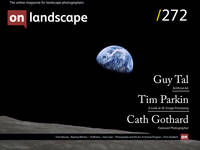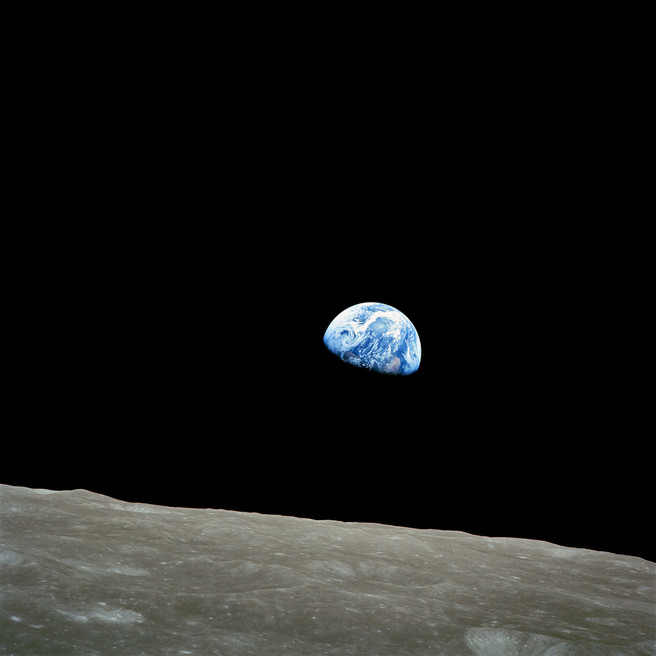Jack Lowe chooses one of his favourite images

Jack Lowe
Jack Lowe is a documentarist using photography, audio recordings and film to tell the story of The Lifeboat Station Project, his 8 year journey to all 238 RNLI lifeboat stations on the coast of the UK and Ireland. Jack photographs and interviews the lifeboat volunteers he meets along the way but there’s a twist! Travelling in his mobile darkroom — a decommissioned ambulance called ’Neena’ — Jack uses Victorian photographic techniques to hand-make the images on glass. Head to his website to see the hundreds of photographs made over the last five years and to find out how you can support and follow the rest of his journey.
Once a photograph of the Earth, taken from outside, is available, a new idea as powerful as any in history will be let loose.~Fred Hoyle, 1948
There are very few scenes that haven’t been gazed upon and photographed here on Planet Earth.
From the deepest oceans to the highest mountains, just about everything’s been done.
But there’s one very simple scene that the astronauts of Apollo 8 weren’t prepared for as they hurtled towards the Moon in 1968: what Earth would look like from space.
They were so intent on their mission, so focused on reaching the Moon, that they hadn’t thought what Earth might look like when they left home, but, boy, they were certainly about to be confronted with it.
It’s quite natural for that to happen, of course, particularly with their intense training and the focus required to achieve such a goal.
But there’s a lesson to be learned here about the human condition: we can be so focussed on a distant dream or goal that we often omit to admire and absorb the splendour along the way.
It wasn’t until the astronauts had achieved a major part of their task — to launch safely into space and inject into lunar orbit — that they were able to pause, look around and truly appreciate the beauty of their now distant home and everything they held dear within it.
This phenomenon has a name. It’s called The Overview Effect: a greater, perhaps spiritual, appreciation of our planet when seen from space; that any borders are merely a human fabrication; an “instant global consciousness” that the planet is one system and that we are, in fact, already in space together on our very own magnificent spaceship.
The astronauts (and everybody around them) were dutifully machine-like in their approach to the mission, but it wasn’t until they were more relaxed that they were able to appreciate a different perspective altogether.
By pausing for a moment, they were able to lift their heads, to look up and allow new sights, experiences and thoughts into life aboard their own temporary tiny spacecraft.
As they say, when you press the pause button on a machine, it stops. But when you press the pause button on human beings, they start.
There even seemed to be a tinge of guilt that they were the people in that position when the unexpected greater purpose to their mission dawned upon them.
Bill Anders humbly wondered if they should have sent poets on Apollo 8 instead of rigorously-trained astronauts. He felt that the three of them perhaps didn’t do justice to conveying the grandeur of what they had seen to their receptive compatriots who were now so very far away.
However, I happen to think Anders was a touch self-critical — I rather like the very simple words he uttered when he looked out of the tiny window and described what he saw:
“Oh my God! Look at that picture over there! There's the Earth coming up. Wow, that's pretty.”
To me, it’s perfect.
Anders then asked Jim Lovell to pass him some colour film, and he duly started clicking away. One of the exposures turned out to be 1/250th of a second that would change the world forever.
As Mission Control in Houston put it: “There’s a picture.”
More simple words to describe such a spellbinding sight. In those moments, the now awestruck people behind Apollo 8 found they’d gone to the Moon, but they'd actually discovered Earth.
The photograph became known as Earthrise — not only one of the most famous, most reproduced and indelible photographs of our time but also cited as ‘the most influential environmental picture ever made’ and for good reason: it’s an image that still resonates around the world, one that sums up both Earth’s rare beauty and vulnerability.
It’s also a landscape photograph that contains every landscape photograph ever made on Earth— indeed, encompassing every photograph you’ve ever made.
Every misty lake, every craggy mountain, every glistening waterfall, every windswept tree, every roaring ocean, every sprawling vista.
But more than that, as Carl Sagan regaled in Pale Blue Dot:
“Look again at that dot. That's here. That's home. That's us. On it everyone you love, everyone you know, everyone you ever heard of, every human being who ever was, lived out their lives.”
Amid our ever-increasing global turmoil, you hold a special gift that affords you the ability to remind others about the wonders on our doorstep.
So, keep making your stunning pictures with vigour and passion.
May they be a reminder to anybody who sees them that the good Earth, the only home we’ve ever known, sure is pretty and sure is worth saving.
Further reading, listening and viewing
- Earthrise on Wikipedia (includes audio recording): https://en.wikipedia.org/wiki/Earthrise
- Earthrise, a film by Emmanuel Vaughan-Lee via Emergence Magazine: https://emergencemagazine.org/film/earthrise/
- The Overview Effect and The Psychology of Cosmic Awe via The Marginalian:https://www.themarginalian.org/2012/12/18/the-overview-effect-and-the-psychology-of-cosmic-awe/
- Pale Blue Dot by Carl Sagan: https://youtu.be/wupToqz1e2g


